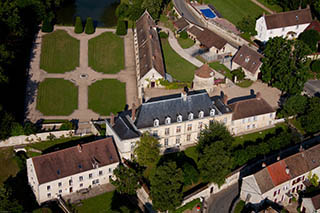Prochain point : lat="" lon=""

Château and Dovecote
An old seigniorial estate in the heart of the village
A CHÂTEAU IN THE STYLE OF LOUIS XIII...
This vast estate, entirely surrounded by a high wall, was part of the fiefdom of Tourly, which Jean Lhuillier, president of the court of auditors and provost of Paris, bought in 1598. Lhuillier’s son, Geoffrey, the king’s advisor in Parliament, built the current château between 1621 and 1623, replacing the former home of the seigniorial farm. He created a well-proportioned, restrained property with little ornamentation except for the horizontal bands beneath the windows and the cornice. The structure looks down slightly onto a terrace, and consists of one main building (made of stone) on two levels, flanked by two wings. It was only called a ‘château’ following the demolition of the château at Brécourt during the Revolution. The grounds include gardens with French-style flowerbeds, a pond, an orchard and a vegetable garden. After passing through the hands of several grand families (the Marais, Mornays and Lhuilliers), the estate was sold as a national property in 1793. The château and its surroundings were included in the additional inventory of historical monuments in 1981.
WITH A DOVECOTE...
The colombier à pied (a ground-level dovecote accessible by foot) is separate from the main house, and dates from the seventeenth century. Built in rough masonry with buttered joints, the dovecote is split into two levels: a lower room used for storage, and an upper room with plaster putlogs (nests for pigeons). Owning a dovecote in the Middle Ages until the Revolution was a right reserved for a seigneur. Pigeons were bred for both the fertiliser they produced (extracted from the manure) and for their meat. The damage caused by the birds gave rise to many complaints in the list of grievances at the Revolution. The lofts, which were a sign of feudal power, were often vandalised during this period. There are about thirty remaining dovecots in Vexin Français.
... WITH THE SERVICE QUARTERS IN AN EXTENSION...
Only the service quarters (a continuation of the château) remain of the old seigniorial mansion, together with the buildings of the old farm overlooking the garden. The farm, which is forty-seven metres long and is on two levels, was almost certainly used as a tithe barn for storing crops. The tithe was a tax collected for the benefit of the clergy, and was introduced to maintain the property of the church. It was payable by the peasantry, and was imposed on a tenth of their crops (craftsmen were also required to supply a tenth of their production). A dispute broke out in 1720 over the allocation of levies between the lord of the manor and the priest, splitting the village into two clans - an enmity that lasted more than ten years.




